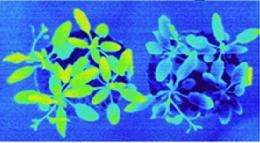On guard against drought

Identification of a gene that helps plants to conserve water under drought conditions will bring biologists closer to understanding how plants tolerate drought. Researchers, led by Takashi Kuromori at Japan's RIKEN Plant Science Center, Yokohama, report this discovery in The Plant Journal.
In order to grow, green plants must take up carbon dioxide via gas exchange from the atmosphere for photosynthesis, which occurs through tiny pores called stomata on the surface of leaves and other aerial organs. However, plants also lose water during this opening through a separate process called transpiration.
During drought, plants protect themselves from excessive water loss by closely regulating stomatal opening and closing. Each stomatal pore is flanked by a pair of kidney-shaped guard cells. When the plant becomes desiccated, the plant hormone abscisic acid (ABA) mediates the drought response by facilitating stomatal closure through its action on the specialized guard cells. Only when sufficient water is available do the guard cells change back to their original shape, opening the pore and allowing transpiration to resume.
“We wish to understand the molecular mechanisms that trigger guard cell responses to environmental and hormonal stimuli,” explains Kuromori.
Working with the plant Arabidopsis thaliana, Kuromori and colleagues previously identified a gene called AtABCG25, which is expressed in vascular tissues and is involved in ABA transport and responses*. In their latest work, they identified a related gene called AtABCG22, which is expressed predominantly in guard cells and regulates stomata in Arabidopsis. Both genes encode ‘ATP-binding cassette’ (ABC) transporter proteins, which use chemical energy stored in the biological molecule ATP to ferry other molecules across cell membranes.
Evaporative cooling during transpiration reduces leaf temperature. Thermal imaging methods can therefore be used to monitor transpirational water loss (Fig. 1). Using such methods, the researchers showed that mutant plants lacking functional AtABCG22 protein had lower leaf temperature and increased water loss compared to normal, wild-type plants. They also found that the mutant plants were more susceptible to drought stress than were wild-type plants. “These findings imply that AtABCG22 plays a role in stomatal regulation and in protecting plants against drought stress,” says Kuromori.
Further experiments, in which the researchers crossed various mutant plants, revealed that AtABCG22 interacts genetically with other genes already known to be involved in ABA biosynthesis, transport or signaling.
“Our next task will be to identify the exact target molecule, or molecules of AtABCG22,” says Kuromori. “We hope that our work will eventually lead to the breeding of drought-tolerant crop varieties.”
More information: Kuromori, T., et al. Arabidopsis mutants of AtABCG22, an ABC transporter gene, increase water transpiration and drought susceptibility. The Plant Journal 67, 885–894 (2011).
*Kuromori, T., et al. ABC transporter AtABCG25 is involved in abscisic acid transport and responses. Proceedings of the National Academy of Sciences USA 107, 2361–2366 (2010).
Provided by RIKEN















